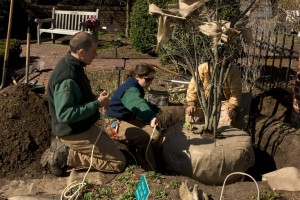Tip of the Week: Guidelines for Tree Planting
Posted in Gardening Tips on February 8 2010, by Sonia Uyterhoeven
 |
Sonia Uyterhoeven is Gardener for Public Education. |
 In last week’s blog post, I discussed the virtues and drawbacks of balled and burlapped (B&B), container grown, and bare-root trees. Before I move on to planting particulars, I’d like to first talk about the roots of trees.
In last week’s blog post, I discussed the virtues and drawbacks of balled and burlapped (B&B), container grown, and bare-root trees. Before I move on to planting particulars, I’d like to first talk about the roots of trees.
The average person on the street would probably describe a tree’s root system as made up of large roots that tunnel deep into the ground. The logic is sound—many trees do have deep vertical tap roots that keep them anchored in the ground and stable.
The majority of a tree’s root system, however, spreads horizontally. These roots are just 12 inches deep and stretch and branch over a large surface, producing tiny hair-like roots that absorb water and nutrients. If you’ve ever seen a fallen tree, you’ll note a sizable horizontal slab of soil that had been uprooted with the tree.
Street trees, then, planted in a tiny pit along a sidewalk, can be especially stressed. Trees in an urban environment are faced with three great challenges: space, soil compaction, and water. The folks at Cornell University’s Urban Horticulture Institute are facing these challenges by using CU-structural soil™ and porous asphalt.
CU-structural soil™ is an interesting combination of stone, soil, and air pores. The stone “lattice” supports heavy loads and meets engineering requirements for urban sites, while the spaces in between the lattice provide enough room for soil particles and air pores that allow for good drainage and aeration, which roots require for good health.
Porous asphalt is exactly what it claims to be, offering a solution to the flooding that occurs when sewers overflow after a heavy rain and providing more moisture to tree roots thirsty for water under compact soils in small planting pits.
Even with these advances in urban tree care, planting is still a disruptive process for the tree. The goal is to make its transition into a new home as easy as possible. These tips will help.
- Plant on an overcast day and in the spring or fall, when the weather is cool.
- Dig the planting hole wide and shallow. Generally, holes should be two to three times as wide as the root system and no deeper than its height.
- Plant the tree so the root flare is level with the soil line. It is better to plant a tree too high than too low (you will suffocate the roots).
- When planting, after adding back half of the soil, water to get rid of air pockets. Fill in the rest of the soil and then gently pat it down.
- Prune out only dead or damaged branches at planting time. Prune for form beginning the following year.
- Do not fertilize at planting time. Fertilizers tend to be high in nitrogen, which encourages top growth—you want to encourage root growth. We add a biostimulant product called Roots™, which encourages root growth.
- To keep in moisture, apply 2–4 inches of mulch; do not pile it around the trunk as that encourages infection and disease.
- Water a newly planted tree weekly for the first several years of its life. Newly planted trees generally need about 20 gallons per week.
- Make a good-sized ring in the soil around the tree and remove the turf so that it doesn’t compete for nutrients. For street trees, avoid planting annuals in the tree pit for the first two years as the roots need time to establish.
- Street tree pits should be as large as possible; the ideal size is 30 inches deep and 8–10 feet wide/long.
One more thing to consider is which trees to plant. Be creative and choose diversity over monocultures. Some interesting options are: (small-size) golden rain tree (Koelreuteria paniculata), Japanese tree lilac (Syringa reticulata), (medium-size) katsura tree (Cercidiphyllum japonicum), yellowwood (Cladrastis kentukea), (large-size) dawn redwood (Metasequoia glyptostroboides), Princeton elm (Ulmus americana ‘Princeton’), and swamp white oak (Quercus bicolor).

